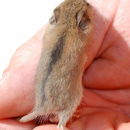en
names in breadcrumbs


Perception Channels: tactile ; chemical
US Federal List: no special status
CITES: no special status
IUCN Red List of Threatened Species: least concern
No documented examples.
No documented examples.
Grey climbing mice are granivorous and insectivorous. Of seven stomachs examined by Dieterlen (1971), three contained a mixture of starchy and fatty seeds, one contained a mixture of seeds and insects, and two contained small beetles. In another study it was found that 100% of the stomachs examined contained seeds and 24% contained Arthropods (Rowe-Rowe 1986).
Dendromus melanotis is found in sub-Saharan Africa, having the most extensive range of any of the four species in the Genus Dendromus (Kingdon 1989). Specifically grey climbing mice are found in South Africa, Lesotho, Swaziland, Botswana, Southern Zimbabwe, Western Mozambique, and the North Eastern corner of Nambia (Stuart 1999). It is believed that D. melanotis is expanding its range (Kingdon 1989).
Dendromus melanotis lives in grasses and shrubs which characterizes the savanna composing the majority of its range (Kingdon 1990). Grey climbing mice are mostly found in grass-brush biotypes (Dieterlen 1990). A study of small mammals in South Africa demonstrated that D. melanotis can be found in coastal lowlands, lowveld, moist upland, highland, and montane areas (Avery 1997). In a 1971 study Dieterlen found that, of the 87 grey climbing mice trapped, 14 were found in dry-grass savanna, 34 in mixed biotypes, and 39 in moist habitats.
Terrestrial Biomes: savanna or grassland
Average lifespan
Status: captivity: 4.2 years.
Dendromus melanotis has a body length ranging from 6-9 cm and a tail length of 7.5-13 cm. The pelage is ash-grey with a dark dorsal stripe, and white or off-white underparts. Grey climbing mice have a long, prehensile tail, three digits per hand, unusually large eyes, and females have eight mammae. (Stuart 1999; Dieterlen 1990; Kingdon 1989).
Range mass: 8 to 17 g.
Other Physical Features: endothermic ; bilateral symmetry
The gestation period for D. melanotis is 23-27 days. Litters of five to eight young are born in the summer (Stuart 1999). Grey climbing mice are born without hair and undeveloped, weighing about 1 gram. The eyes open 20-24 days after parturition. It then takes another 4-5 weeks for the young to be weaned. It is unknown at what age grey climbing mice reach sexual maturity. Dendromus melanotis has a life span of 3-4 years in captivity, but it is not presently known if this is representative of its life span in the wild (Dieterlen 1990).
Key Reproductive Features: gonochoric/gonochoristic/dioecious (sexes separate); sexual
Average gestation period: 25 days.
Average number of offspring: 4.6.
The gray climbing mouse (Dendromus melanotis) is a species of rodent in the family Nesomyidae. It is found in Angola, Benin, Botswana, Democratic Republic of the Congo, Ethiopia, Guinea, Liberia, Malawi, Mozambique, Namibia, Nigeria, Rwanda, South Africa, Eswatini, Tanzania, Uganda, Zambia, and Zimbabwe. Its natural habitats are dry savanna, Mediterranean-type shrubby vegetation, subtropical or tropical dry lowland grassland, and temperate desert.
The gray climbing mouse (Dendromus melanotis) is a species of rodent in the family Nesomyidae. It is found in Angola, Benin, Botswana, Democratic Republic of the Congo, Ethiopia, Guinea, Liberia, Malawi, Mozambique, Namibia, Nigeria, Rwanda, South Africa, Eswatini, Tanzania, Uganda, Zambia, and Zimbabwe. Its natural habitats are dry savanna, Mediterranean-type shrubby vegetation, subtropical or tropical dry lowland grassland, and temperate desert.